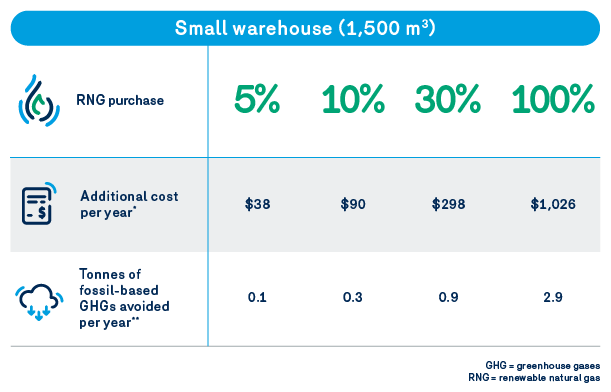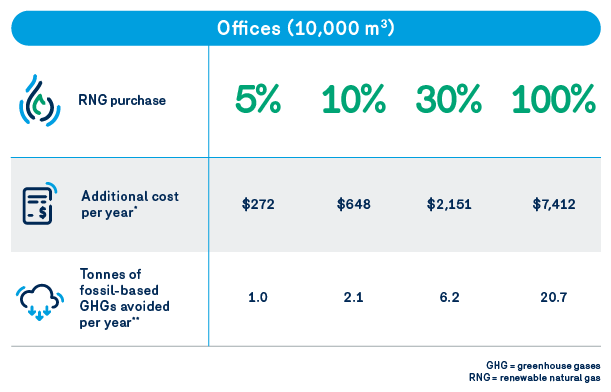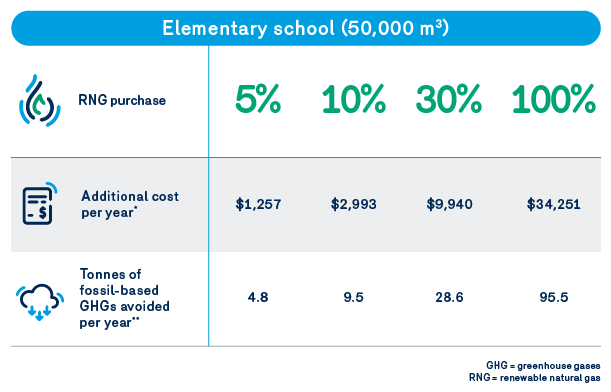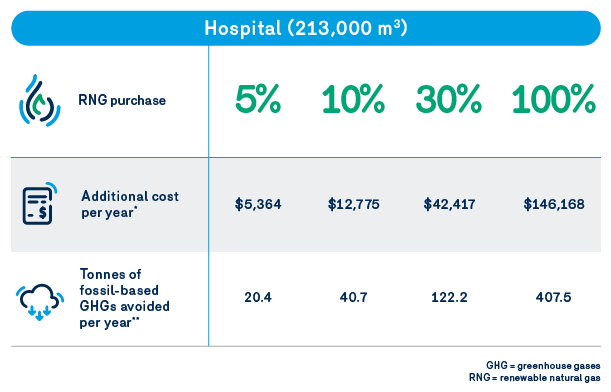Switching to RNG is easy!
Add RNG to your purchasing profile according to your needs and objectives. You have to options:
When you purchase renewable natural gas, you’re helping to improve your GHG balance, because your purchase of RNG replaces the purchase of an equivalent amount of fossil natural gas.
Since RNG and fossil natural gas circulate in the same north-american gas distribution system, their molecules mix together, making it impossible to confirm the exact quantity of RNG molecules that will reach your devices. While we cannot physically deliver to you the percentage of RNG purchased, your share is exclusively attributed to you and is reflected on your bill. Your purchase of RNG helps improve your GHG balance by reducing the GHG emissions targeted by the fight against climate change.
In addition, Énergir guarantees that the total amount it procures from RNG producers is greater than the quantity purchased by all its customers, as verified by the Bureau de normalisation du Québec.
For more information on GHG emissions from renewable natural gas and how to account for them in your GHG balance according to recognized GHG emissions quantification standards such as ISO 140064, see the questions and answers on our website: “Does RNG emit GHG emissions?” “How are GHG emissions from RNG combustion accounted for?” and “How do RNG purchases impact Énergir customers?”

Flexible purchasing
Add 1% to 100% RNG to your purchasing profile right in your Customer Space. You can adjust the RNG percentage according to your objectives and needs.
Need clarification? The what confirms my purchase is here to guide you.
How to choose your percentage
Use your Customer Space to estimate how different RNG purchase percentages will affect your bill and your fossil-based GHG balance, with no obligation to purchase.
Here’s a quick guide to incorporating RNG into your purchasing profile.
Log in to the Customer space. If you don't have an account, choose the "Create my account" option.

On the home page, click on 'Open the Renewable Natural Gas Space'. If you have more than one account, select the one you want first.
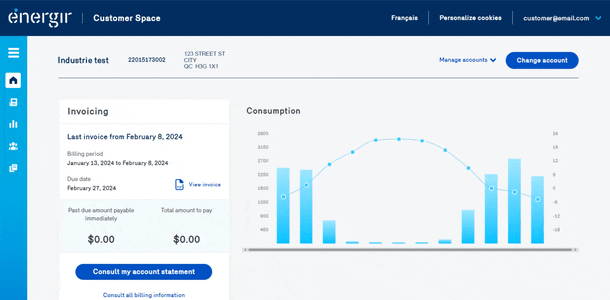
Click the "Create" option next to the relevant address.
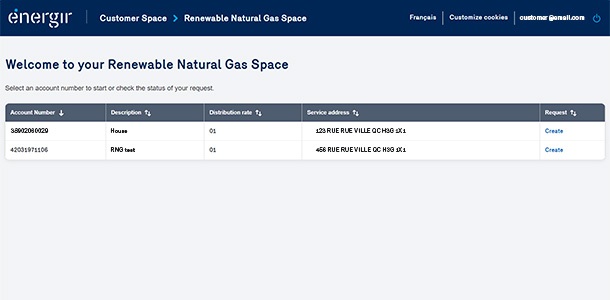
Move the cursor to determine the quantity of RNG and compare the effects on your monthly bill and on the environment.
To find out more about RNG's GHG emissions, see our frequently asked questions.
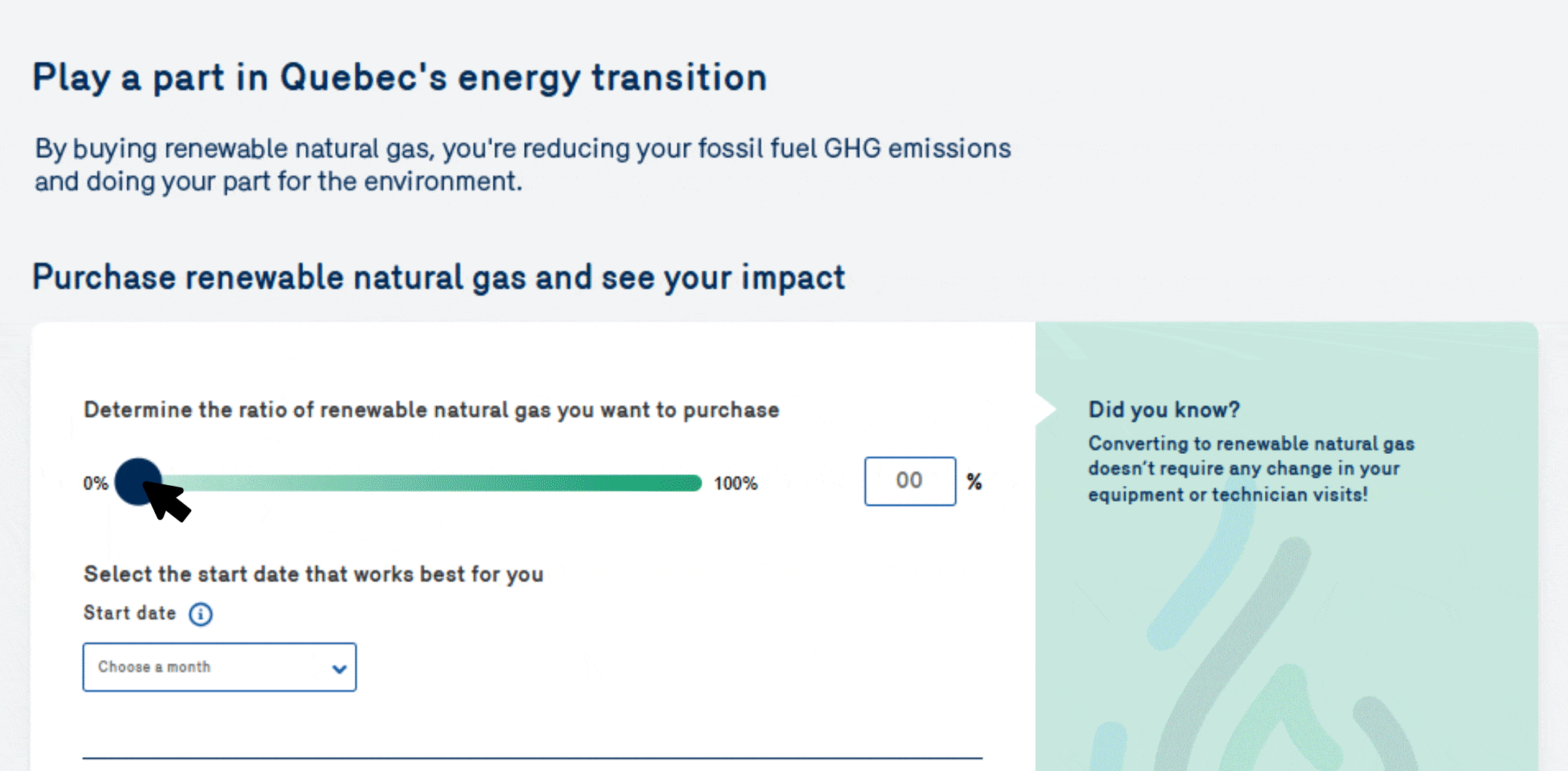
Enter the desired percentage and start date.
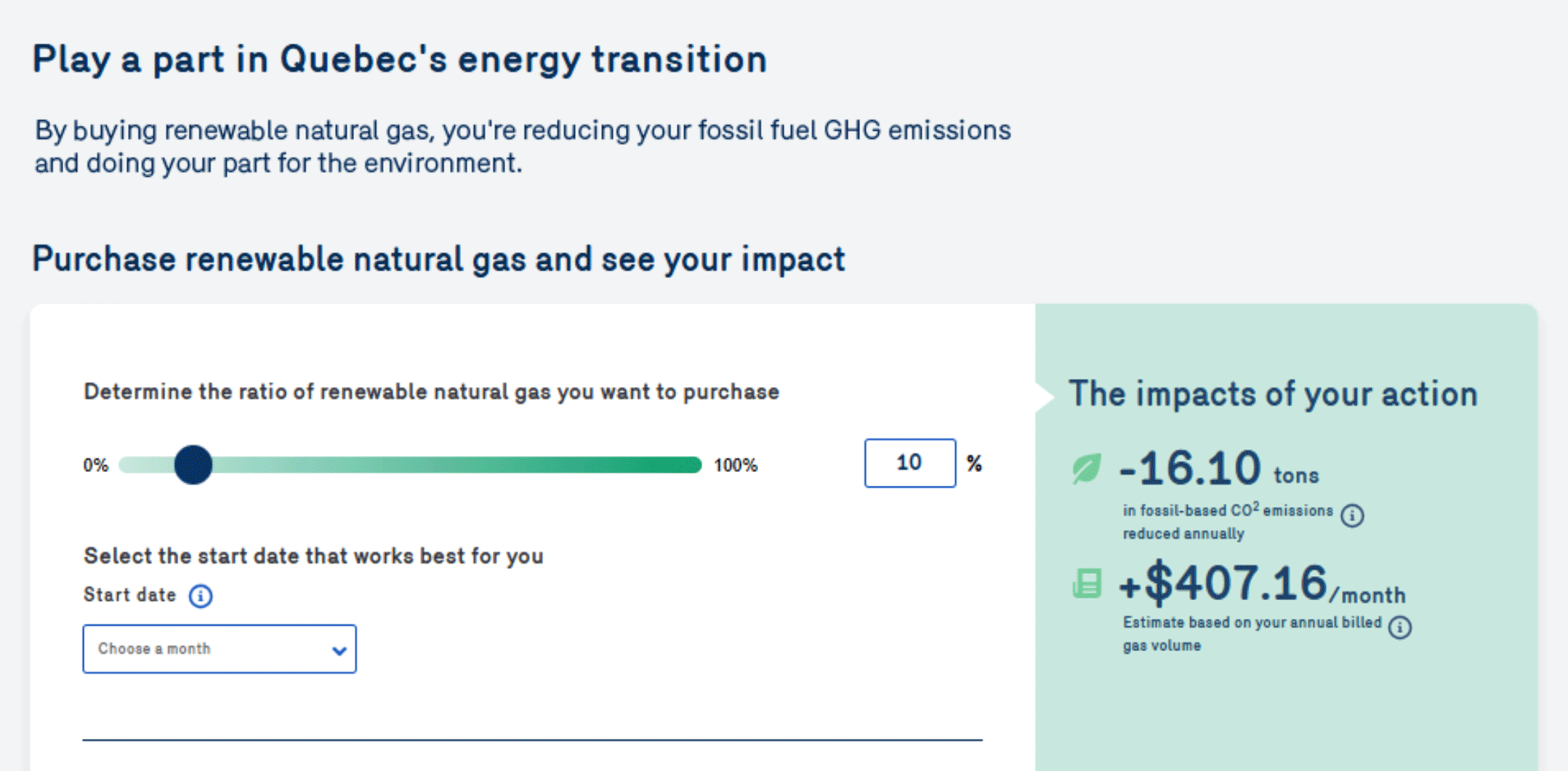

Good to know
You can easily change your percentage at any time, right in your Customer Space.
Get in on the Decarbonization Incentive Program (DIP)
In signing a firm 5-year agreement to purchase a minimum of 5% RNG, you could be eligible for a grant. Contact us to learn more about the terms and conditions of the program and to sign the agreement.
What does RNG costs?
As of October 1, 2025, the price of RNG is ¢94.884/m3 or $25.04/GJ.
The annual RNG supply rate is set annually as part of the rate case filed each year with Régie de l’énergie.
Énergir’s SPEDE billing rate does not apply to the percentage of RNG purchased.
By purchasing a percentage of RNG equal to or greater than the regulatory obligation target, you will be exempt from the socialization fees.
To find out more, visit the page Energir | Pricing and Rates.
Customer profiles
Adding RNG to your purchasing profile can be a smart way to improve your business’s GHG balance without having to change your equipment. Compare the effect of different RNG purchase percentages on the bill and on avoided fossil-based GHG emissions.
* Natural gas and RNG rates applied in October 2025
** For more information on the methodology used to calculate greenhouse gas (GHG) emissions reduction data, see our methodology page.
Questions?
We've got answers.
There is no way to confirm the exact amount of purchased RNG that is delivered to your devices, since RNG and fossil natural gas flow through the same gas network and the molecules mix together. The same applies to electricity that is purchased: you can’t tell which dam or wind turbine generated the electrons that are lighting your home.
Énergir has put in place rigorous measures at regular intervals to ensure that its total supply on an annual basis from RNG producers, as a replacement for fossil natural gas, is at least equal to the quantity purchased by all its customers. Following the end of a given year, Énergir has its RNG supply and inventory verified annually by the Bureau de normalisation du Québec (BNQ). The volumes of RNG you purchase are shown on your detailed bills for total natural gas consumption.
You can request a change to your renewable natural gas purchase at any time. As a customer, for an effective date of the first of the following month, you must submit your request no later than the 20th of the current month. Requests received after the 20th of the month will be processed with the following month’s requests. The change request is made directly in your Customer Space by specifying the revised purchase percentage and desired effective date.
No modifications to equipment are required since RNG and fossil natural gas are interchangeable. RNG can therefore be used for the same purposes.
To meet regulatory targets for RNG deliveries, Energir sources most of its RNG from producers in North America. It is working to increase its supply from producers in Quebec.
The quantity of RNG purchased by Energir from each producer is injected by the latter into the gas network of the region where the producer is located. It can therefore be injected into the gas network of Energir or another distributor in North America, and then mixed with the fossil natural gas circulating in the same gas network. So, as with its fossil natural gas supply or electricity supply, once the purchased energy is injected into the gas or electricity grid, it is not possible to track the gas molecule or electron. The gas molecule or electron is consumed by the various users connected to these networks.
The quantity of RNG purchased by Énergir reduces the quantity of fossil natural gas that Énergir buys as part of its overall supply. Given that RNG and fossil natural gas molecules circulate in the same gas network and mix without it being possible to distinguish between them, Energir has its total annual supply from RNG producers verified by the Bureau de normalisation du Québec to be at least equal to the quantity of RNG purchased by all its customers, and that the RNG purchased is of 100% organic origin (and does not include any fossil molecules).
RNG combustion is not emission-free; it generates GHG emissions (CO2, CH4 and N2O) in the same way as the combustion of fossil natural gas. CO2 is the main GHG that is generated (over 99% of combustion emissions). However, unlike the emissions resulting from the combustion of fossil natural gas, CO2 emissions from RNG combustion are not included in emissions targeted by the fight against climate change. Fossil natural gas combustion releases CO2 that has been sequestered for millions of years in geological formations. In contrast, the CO2 released into the atmosphere from RNG combustion (known as biogenic CO2) was sequestered in organic matter (food waste, manure, wastewater, etc.) that renews much more rapidly. Biogenic CO2 was therefore in the atmosphere not so long ago, was absorbed by organic matter, and will be re-absorbed. The effect of biogenic CO2 on the climate depends on a variety of factors, including the source of organic waste.
Although also biogenic, N2O and CH4 combustion emissions (less than 1% of combustion emissions) from RNG must be reported in the direct emissions (Scope 1 emissions) of the person or entity using RNG in their GHG inventory.
The biogenic CO2 emitted during combustion must also be quantified, but reported separately from Scope 1 emissions in the GHG inventory. Regulations governing the GHG cap-and-trade system (CATS) stipulate that these CO2 emissions must be reported, but do not have to be covered by emission allowances under Quebec’s GHG cap-and-trade system.
In contrast, all GHG emissions (CO2, CH4 and N2O) from fossil natural gas combustion must be reported in the direct emissions (Scope 1 emissions) of the person or entity using fossil natural gas in their GHG inventory.
RNG production emits GHGs. GHGs are also emitted during RNG transmission and distribution.
Énergir has a regulatory obligation to deliver a minimum amount of RNG during its fiscal year (2% in 2023-2024, 5% in 2025-2026 and 10% in 2030-2031). If customers do not voluntarily purchase a portion of that RNG, Énergir has to socialize the cost of the unsold volumes among customers who do not purchase the minimum quantity required by regulations. Thus, if demand from voluntary customers does not exceed the regulatory threshold regarding the quantity of RNG to be delivered, voluntary purchases will not impact the reduction of GHG emissions in Québec attributable to RNG. Conversely, if voluntary purchases exceed that regulatory threshold, they enable a further reduction of GHG emissions from RNG with respect to Québec.
Customers can include their RNG purchases in their GHG inventory. For more details on how to include GHG emissions from RNG combustion in a GHG inventory, see the question above “How are GHG emissions from RNG combustion accounted for?” .
It is a charge that spreads the costs associated with the volume of RNG to meet the regulatory obligation and that is unsold among customers likely to make purchases. Energir has a regulatory obligation to deliver a certain amount of RNG in its system. When a portion of this RNG is not voluntarily purchased by its customers, Énergir must socialize the cost of the unsold volumes among customers who have not purchased the quantity of RNG from the regulatory threshold (i.e., 2% in 2023-2024, 5% in 2025-2026 and 10% in 2030-2031).


